By far the most interesting game we analyzed during Mike Splane’s last chess party was a game from the U.S. Amateur Team West that was shown by Barry Curto.
By the way, before I get into that game, I’d like to respond to Mike’s comment on my last post. He said that one of his hopes when he started these chess parties was that they might help the regular attendees improve. And in fact, we had prize-winners from three different teams at this last party! I’ve already mentioned that I was on the first-place team and Mike was on the second-place team at the USATW. But I didn’t realize that also Felix Hernandez-Campos was on the top under-2000 team! I can’t give all the credit to Mike’s parties, but maybe some?
Richard Koepcke said that he had asked Barry Curto to show us his game from the first round of the USATW against NM Andy Lee. Barry is a class-A player, so this game on paper was a bit of a mismatch, but it is a really impressive example of how a master administers a good old-fashioned whuppin’ on a class player. Nevertheless, Barry definitely had some opportunities to survive, so there are some good lessons to be learned.
Let’s start with the position after Black’s 8th move.
White to play.
Black has just played 8. … e5, offering a pawn sacrifice. Barry said that Andy Lee thought about this move for about 20 minutes. Although it’s a very thematic move for positions where White has played c4-c5, still it takes some serious calculation. What do you think White should do here? Should he take up the gauntlet with 9. de, or just ignore the sac and continue developing?
At the chess party the prevailing opinion was that White should have taken the pawn. The main reason is that we felt that after 9. de Nd7 10. Nxd5 Black is not going to win back both pawns and he is not going to get full compensation. For that reason we considered 9. de Ne8 to be the more promising continuation for Black. But this move is a little bit awkward and doesn’t put as much pressure on White’s center.
Looking at the position with Rybka really clarifies the debate in this case. First, after 9. de the computer does consider 9. … Nd7! to be the right move. It’s the principle I enunciated in a blog post a few weeks ago: you often get better play by sacrificing two pawns than one! Rybka gives Black complete equality after 9. de Nd7 10. Nxd5 Nxe5 11. Bc3 Nbc6. We got this far in our chess-party analysis too, but then we mistakenly thought that 12. Nxe7+? is good for White, when in fact it’s terrible. See the PGN viewer below for further details.
Even though accepting the gambit is the principled move, Barry actually made a great practical choice. To paraphrase what Emmanuel Lasker once said, if your opponent thinks 20 minutes and then offers a pawn, it’s reasonable to assume that it might be dangerous to take it! (Especially if your opponent is rated more than 300 points above you.)
So Barry didn’t bat an eye, and he continued 9. Bd3 Nc6 10. Nge2 ed 11. ed, leading us to the next diagram. I actually like his decision, even though I was one of the people arguing that he should have taken the pawn. He just keeps on playing good solid developing moves, and puts the onus on his opponent to show that there is something wrong with that.
Black to move.
This is a fascinating position, both from the chess and the psychological point of view.
Andy Lee swung for the fences here by sacrificing a piece with 11. … Nxd4!? Is this sacrifice good? Why did he play it?
Here’s what I think. First of all, I think that Black’s earlier pawn sac shows that he does not respect White’s opening play. In particular he doesn’t believe in the move 8. c5, and he is trying to refute it. But White has been calmly developing, and Black feels that if he does not strike now his advantage is going to slip away.
Second, we have to look at the rating difference. I’m not sure whether this entered into Andy’s calculations or not, but it might have.
Back in the nineteenth century, chess players were fond of sacrificing material whether it was sound or not. But eventually a more scientific approach to chess prevailed, and the textbooks now say that you need to wait for your opponent to make a mistake first, and only then can you consider sacrificing material.
Well, it’s a lie. The old nineteenth-century approach can still work, especially when your opponent is rated 300 points below you. You can play a sacrifice that is not necessarily sound, but that makes the position so difficult that your opponent is almost sure to make a mistake. I’ve done this myself. There was one time a few years back that I beat class-A players in three consecutive tournaments with sacs exactly like this — giving up a piece for two pawns and a whole lot of obscure compensation (mostly my opponent’s king being stuck in the middle). I even started saying that the way to beat class-A players is to sac a piece against them (which isn’t really true).
The moral, for Barry and the other class players out there, is that when your master opponent unexpectedly sacrifices a piece, you shouldn’t throw in the towel. In fact, this may be your best opportunity to beat them. If you believe that you have been playing sound chess, don’t give up! Stick to your guns!
What should Black do in the above position? To me there is one obviously best move, with a fork in the road at the next move. Black should play 11. … Re8. White is almost certain to reply 12. O-O. Then there is a choice. One possibility is to play tactically with 12. … Nxd4 (in this case it’s no longer a sacrifice, as Black is assured of getting his material back) 13. Nxd4 Bxc5 14. Ne2 Rxe2! 15. Qxe2 Bxd4+ 16. Be3 Bxe3 17. Qxe3. Black has two pawns for the exchange but White is better developed. I’d say it’s even or perhaps a small advantage for White, so this line is not particularly appealing if you think that White’s 8. c5 was an error that needs to be punished.
The other approach is positional play with 12. … Bf8 13. Be1 (say) g6. Black will, I think, continue to have pressure on White’s weak dark squares, particularly the pawns on e3 and c5, and he can continue with some combination of the moves … Bh6, … Nh5, … f5, … b6 etc. I wouldn’t claim any great advantage, but I’d probably rather be playing Black. If the players were equal in strength or if White were higher rated, this is definitely the way I would advise Black to proceed.
[Correction: The above line actually makes sense only if Black delays the exchange in the center. So actually I’m saying that Black should have played 10. … Re8 11. O-O Bf8 etc. The idea is to keep the position closed so that White’s congestion works against him, and also to keep the pawn on e3 as a target.]
But I admire Andy Lee’s courage, if not his wisdom, in playing this sac!
The game continued 12. Nxd4 Bxc5 13. Nce2? This was already a key decision, and Barry chose the wrong knight. At the party I didn’t understand the argument for 13. Nde2, but I do now. The point is that tempi are critical here. White doesn’t have a lot of fundamental weaknesses, so Black’s advantage is certainly in the short run, not in the long run. Black either needs to checkmate White or else he needs to overrun White with his pawn majority.
The move 13. Nde2 saves a tempo and gives White a chance to slow down Black’s pawn roller considerably. Rybka rates the position as +0.7 pawns in White’s favor after 13. Nde2, but even after the move Barry played, 13. Nce2.
How can Black take advantage of White’s mistake?
Position after 13. Nce2. Black to play.
Interestingly, Black also misjudged the position here and played 13. … Bb6? It’s understandable that Black would want to keep this great bishop on the board. But especially when you’ve sacrificed material, concrete threats have to take precedence over general principles.
Mike Splane argued that Black should have played 13. … Bxd4! and the computer agrees. After 13. … Bxd4 14. Nxd4 c5 the pawns start to march, just as in the game, and we couldn’t find any clear salvation for White. A very important point is that White is not able to castle to safety in the line 15. Nb5 Re8+ 16. Be2 Qb6! 17. a4 d4, because 18. O-O? would lose a piece to 18. … d3! 19. Bxd3 c4+!
Andy’s move gave Barry one more chance to slow down Black’s momentum by playing 14. b4! This allows White to maintain his strong point on d4, and it’s hard to see how Black can break through.
Instead Barry played 14. Qc2?, and now the game was nearly lost for White. It seems to me that Barry just kept playing “reasonable” moves in this game (like 9. Bd3 and 10. Nge2, but at some point you need to quit playing generic reasonable moves and really take a look at the concrete threats in the position. This is the same criticism I just made for Black, but the consequences are a whole lot worse for White because he is the one under attack.
Now Andy played 14. … c5, and you can just hear the bugles sounding “Charge!” White’s pieces are all in the way of Black’s advancing infantry, and that’s a bad place for them to be. Barry played 15. Nb5. Here again is a “reasonable” move that fails to take into account the concrete threats. White should realize that he has no other way to hold back the advancing hordes than to play 15. Be3! and return the piece. As I said at the chess party, “It’s better to be down a pawn than down a king.” (This was my best line of the day.)
Andy continued with 15. … c4 16. Bf5 and now the nice 16. … d4!
Position after 16. … d4! White to move.
This is basically Black’s dream position. He threatens to win a piece in two different ways with … d3. Notice also that White cannot give up a piece for two pawns with 17. Qxc4 Bxf5 18. Nbxd4 because after 18. … Rc8! White’s queen runs out of good squares.
This position reminds me very much of the Halloween Gambit (1. e4 e5 2. Nf3 Nc6 3. Nc3 Nf6 4. Nxe5?!), where White sacrifices a piece for two pawns and an incredible mobile pawn mass in the center.
White was forced to play 17. Bxc8 Rxc8, and now after 18. Qc1 Re8 19. Kf1 Black finally got to play a little tactical trick.
Black to play and win.
Here Andy smashed White’s last resistance with 19. … Rxe2! 20. Kxe2 Qe8+, forking White’s king and knight. After 21. Kf2 Qxb5 we have a position with a similar material balance to the line I gave after 11. … Re8 12. O-O Nxd4. However, Black ends up with a much better position than he would have in that earlier line, as his pieces now dominate the board.
It’s interesting that Black’s winning combination was very similar to the one in the note to move 11 (in both cases, sacrificing a rook on e2 in order to win the other knight). Sometimes you just need to wait for a threat to ripen!
If you’re interested in playing through the whole game (including the parts before 9. Bd3 and after 21. … Qxb5), check out the PGN viewer below.
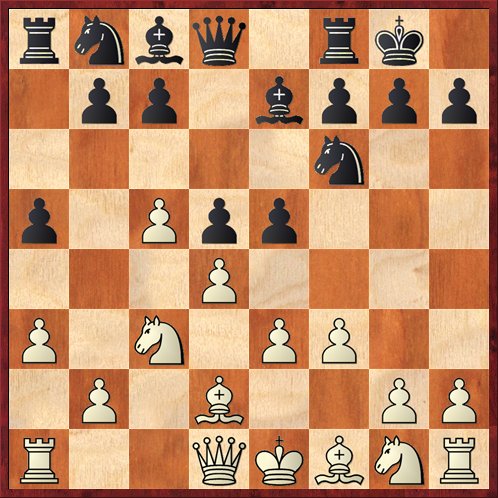
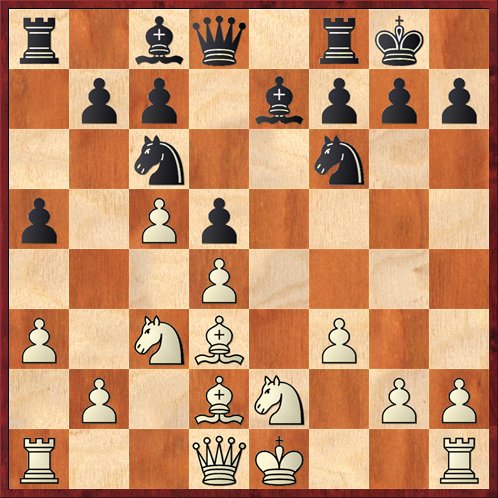
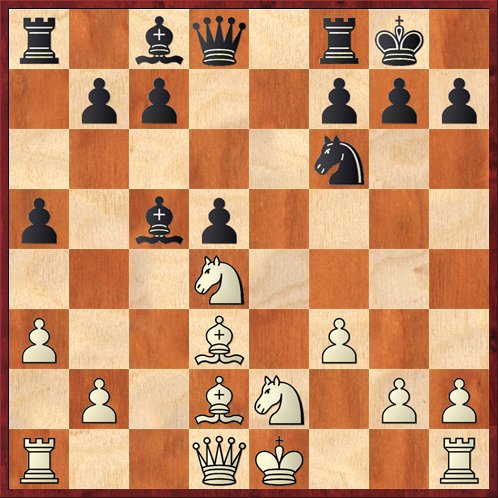
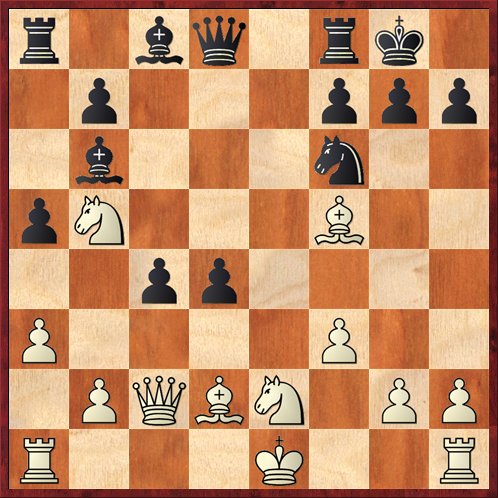
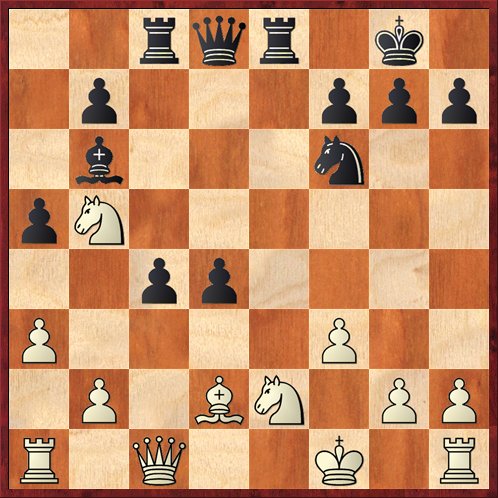



{ 2 comments… read them below or add one }
Small nit: starting at the top of column and for quite a bit of the discussion, it’s tough for the reader to figure out who has which color.
A very useful game to see, especially the analysis of the piece sacrifice. Thanks!